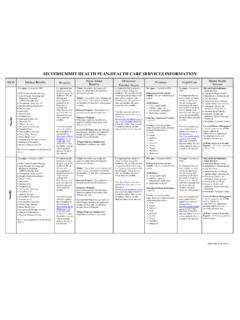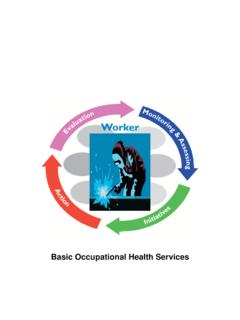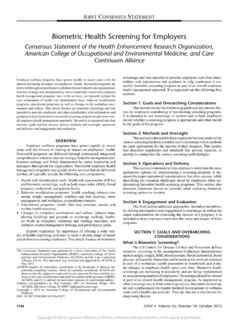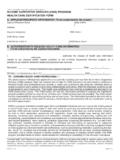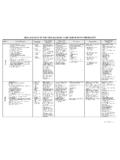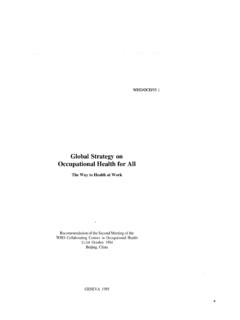Transcription of OCCUPATIONAL THERAPY PRACTICE FRAMEWORK …
1 ContentsPreface ..S1 Definitions ..S1 Evolution of This Document ..S2 Vision for This Work ..S3 Introduction ..S3 Domain ..S4 Occupations ..S5 Client Factors ..S7 Performance Skills ..S7 Performance Patterns ..S8 Context and Environment ..S8 Process ..S9 Overview of the OCCUPATIONAL THERAPY Process ..S10 Evaluation Process ..S13 Intervention Process ..S14 Targeting of Outcomes ..S16 Conclusion ..S17 Tables and Figures Table 1 . Occupations ..S19 Table 2 . Client Factors.
2 S22 Table 3 . Performance Skills ..S25 Table 4 . Performance Patterns ..S27 Table 5 . Context and Environment ..S28 Table 6 . Types of OCCUPATIONAL THERAPY Interventions ..S29 Table 7 . Activity and OCCUPATIONAL Demands ..S32 Table 8 . Approaches to Intervention ..S33 Table 9 . Outcomes ..S34 Exhibit 1 . Aspects of the Domain of OCCUPATIONAL THERAPY ..S4 Exhibit 2 . Process of OCCUPATIONAL THERAPY Service Delivery ..S10 Exhibit 3 . Operationalizing the OCCUPATIONAL THERAPY Process ..S17 Figure 1.
3 OCCUPATIONAL THERAPY s Domain ..S5 Figure 2 . OCCUPATIONAL THERAPY s Process ..S10 Figure 3 . OCCUPATIONAL THERAPY Domain and Process ..S18 References ..S36 Authors ..S40 Acknowledgments ..S40 Appendix A . Glossary ..S41 Appendix B . Preparation and Qualifications of OCCUPATIONAL Therapists and OCCUPATIONAL THERAPY Assistants ..S47 Copyright 2014 by the American OCCUPATIONAL THERAPY Association . When citing this document the preferred reference is: Ameri-can OCCUPATIONAL THERAPY Association.
4 (2014) . OCCUPATIONAL THERAPY PRACTICE FRAMEWORK : Domain and process (3rd ed .) . American Journal of OCCUPATIONAL THERAPY , 68(Suppl . 1), S1 S48 . http://dx .doi .org/10 .5014/ajot .2014 .682006 The American Journal of OCCUPATIONAL THERAPY S1 Copyright 2014 by the American OCCUPATIONAL THERAPY OCCUPATIONAL THERAPY PRACTICE FRAMEWORK : Domain and Process, 3rd edi-tion (hereinafter referred to as the FRAMEWORK ), is an official document of the American OCCUPATIONAL THERAPY Association (AOTA). Intended for oc-cupational THERAPY practitioners and students, other health care professionals, educators, researchers, payers, and consumers, the FRAMEWORK presents a sum-mary of interrelated constructs that describe OCCUPATIONAL THERAPY the FRAMEWORK , OCCUPATIONAL THERAPY is defined asthe therapeutic use of everyday life activities (occupations)
5 With individ-uals or groups for the purpose of enhancing or enabling participation in roles, habits, and routines in home, school, workplace, community, and other settings. OCCUPATIONAL THERAPY practitioners use their knowl-edge of the transactional relationship among the person, his or her en-gagement in valuable occupations, and the context to design occupa-tion-based intervention plans that facilitate change or growth in client factors (body functions, body structures, values, beliefs, and spirituality) and skills (motor, process, and social interaction) needed for successful participation.
6 OCCUPATIONAL THERAPY practitioners are concerned with the end result of participation and thus enable engagement through ad-aptations and modifications to the environment or objects within the environment when needed. OCCUPATIONAL THERAPY services are provided for habilitation, rehabilitation, and promotion of health and wellness for clients with disability- and non disability-related needs. These services include acquisition and preservation of OCCUPATIONAL identity for those who have or are at risk for developing an illness, injury, disease, disorder, condition, impairment, disability, activity limitation, or participation restriction.
7 (adapted from AOTA, 2011; see Appendix A for additional definitions in a glossary)When the term OCCUPATIONAL THERAPY practitioner is used in this document, it refers to both OCCUPATIONAL therapists and OCCUPATIONAL THERAPY assistants (AOTA, 2006). OCCUPATIONAL therapists are responsible for all aspects of oc-cupational THERAPY service delivery and are accountable for the safety and ef-fectiveness of the OCCUPATIONAL THERAPY service delivery process. OCCUPATIONAL THERAPY assistants deliver OCCUPATIONAL THERAPY services under the supervision of and in partnership with an OCCUPATIONAL therapist (AOTA, 2009).
8 Addi-tional information about the preparation and qualifications of OCCUPATIONAL therapists and OCCUPATIONAL THERAPY assistants can be found in Appendix THERAPY PRACTICEFRAMEWORK: Domain & Process 3rd EditionDownloaded From: on 03/31/2016 Terms of Use: March/April 2014, Volume 68(Supplement 1)Copyright 2014 by the American OCCUPATIONAL THERAPY of This DocumentThe FRAMEWORK was originally developed to articulate OCCUPATIONAL THERAPY s distinct perspective and contri-bution to promoting the health and participation of per-sons, groups, and populations through engagement in occupation.
9 The first edition of the FRAMEWORK emerged from an examination of documents related to the Occu-pational THERAPY Product Output Reporting System and Uniform Terminology for Reporting OCCUPATIONAL THERAPY Services (AOTA, 1979). Originally a document that re-sponded to a federal requirement to develop a uniform reporting system, the text gradually shifted to describing and outlining the domains of concern of OCCUPATIONAL second edition of Uniform Terminology for Oc-cupational THERAPY (AOTA, 1989) was adopted by the AOTA Representative Assembly (R A) and published in 1989.
10 The document focused on delineating and defining only the OCCUPATIONAL performance areas and OCCUPATIONAL performance components that are addressed in occupa-tional THERAPY direct services. The third and final revision of Uniform Terminology for OCCUPATIONAL THERAPY (AOTA, 1994) was adopted by the R A in 1994 and was expanded to reflect current PRACTICE and to incorporate contextual as-pects of performance (p. 1047). Each revision reflected changes in PRACTICE and provided consistent terminology for use by the Fall 1998, the AOTA Commission on PRACTICE (COP) embarked on the journey that culminated in the OCCUPATIONAL THERAPY PRACTICE FRAMEWORK : Domain and Process (AOTA, 2002b).
